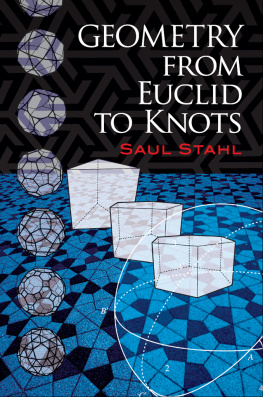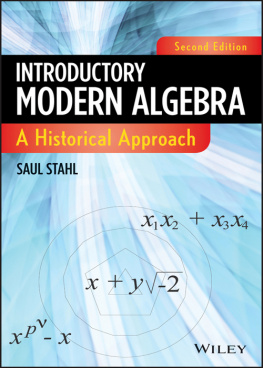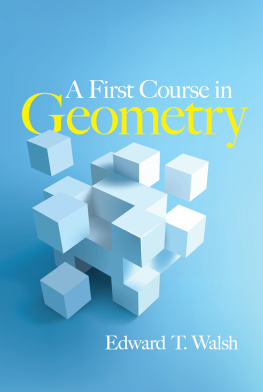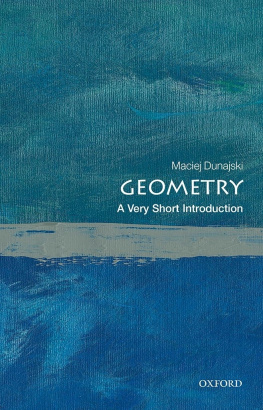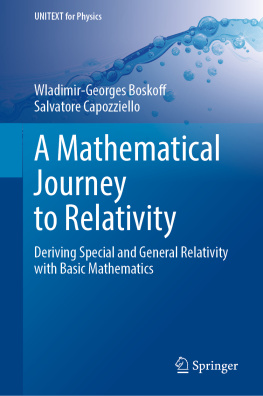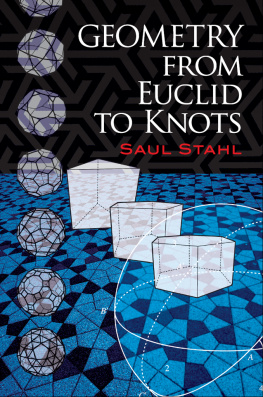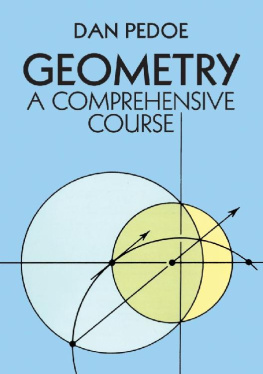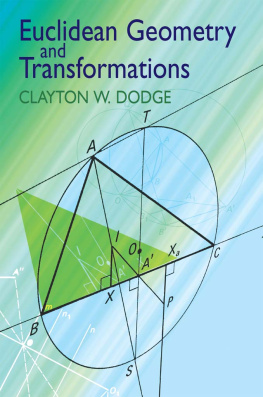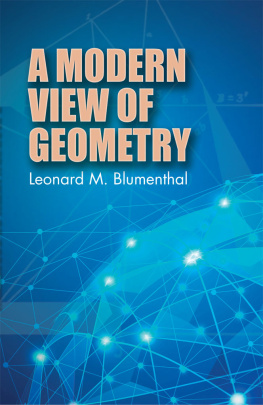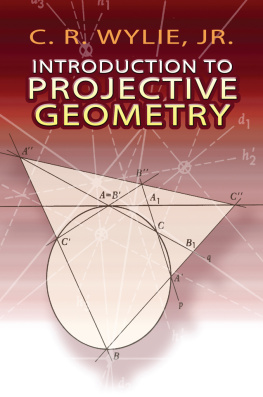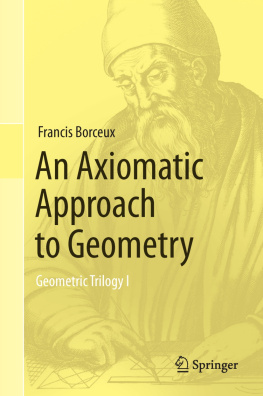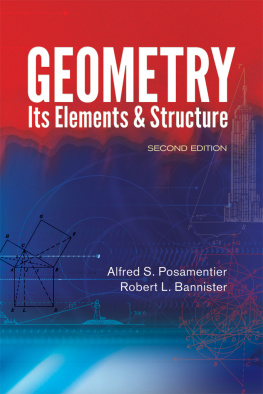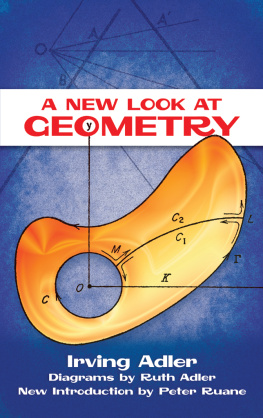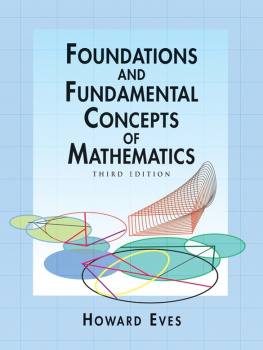GEOMETRY FROM
EUCLID TO KNOTS
SAUL STAHL
UNIVERSITY OF KANSAS
DOVER PUBLICATIONS, INC.
Mineola, New York
Copyright
Copyright 2003, 2010 by Saul Stahl
All rights reserved.
Bibliographical Note
This Dover edition, first published in 2010, is an unabridged republication of the work originally published in 2003 by Pearson Education, Inc., Upper Saddle River, New Jersey. The author has provided a new Preface for this edition. This book can also be downloaded from http://www.math.ku.edu/stahl/.
Library of Congress Cataloging-in-Publication Data
Stahl, Saul
Geometry: from Euclid to knots / Saul Stahl.
p. cm.
Originally published: Upper Saddle River, N.J.: Pearson Education, 2003.
Includes bibliographical references and index.
ISBN-13: 978-0-486-47459-5
ISBN-10: 0-486-47459-3
1. Geometry. I. Title.
QA445.S74 2010
516dc22
2009037891
Manufactured in the United States by Courier Corporation
47459302
www.doverpublications.com
To Aunt Chaya
Two tales, each with a moral that may have been swamped by the spirit of the times:
Egypt's king Ptolemy Soter once asked Euclid whether there was no shorter way in geometry than that of the Elements. There is no royal road to geometry, replied Euclid.
A student, after learning the very first proposition in geometry, wanted to know what he would get by learning these things. Euclid then called his slave and said, Give him a penny since he must needs make gains by what he learns.
From Isaac Todhunters preface to Euclid for the Use of Schools and Colleges (published in 1874, more than two millennia after Euclids death):
Numerous attempts have been made to find an appropriate substitute for the Elements of Euclid; but such attempts, fortunately, have hitherto been made in vain. The advantages attending a common standard of reference in such an important subject, can hardly be overestimated; and it is extremely improbable, if Euclid were once abandoned, that any agreement would exist as to the author who should replace him. It cannot be denied that defects and difficulties occur in the Elements of Euclid, and that these become more obvious as we examine the work more closely; but probably during such examination the conviction will grow deeper that these defects and difficulties are due in great measure to the nature of the subject itself, and to the place which it occupies in a course of education; and it may readily be believed that an equally minute criticism of any other work on geometry would reveal more and graver blemishes.
Contents
Preface to the Dover Edition
It gives me particular pleasure to have this book republished by Dover Publications, Inc. After all, they do list Euclid's The Elements, the most influential mathematical book of all time, in their catalog, and it is hard not to derive some satisfaction from this association. Especially so, as I have had so many occasions to actually consult this source in the preparation of various lectures. The mathematical world owes Dover a debt of gratitude for making this text so readily available.
I must confess that when I opened Euclids book for the first timed during my undergraduate years, I felt rather disappointed. The questionable definitions, the lack of symbolic notation, and, most damning, the seemingly nitpicking proofs of obvious facts, all combined to dull my interest. It was not until I was assigned to teach a course in modern geometries that I returned to Euclids opus. This time I knew more about non-Euclidean geometry, as well as mathematics in general, and so could appreciate it better. It is for this reason that the first chapter of this book is devoted to the concrete and plausible description of several alternative, non-Euclidean, geometries. Familiarity with other geometries shows the students that the obvious need not be true. This demonstrates to them the need for logical proofs. That this can be accomplished by introducing the students to the geometry of the upper halfplane, a mathematical tool that played an essential role in the recent resolutions of Fermats and Poincars conjectures, as well as in the classification of the finite simple groups, comes as a bonus.
The readers who know of my junior/senior level textbooks in algebra and real analysis might wonder why in writing this book I chose to depart from the historical, or evolutionary, approach to pedagogy. The reason is that since I myself found it impossible to conceive of a hyperbolic geometry without a model, I did not deem it realistic to expect my students to do so. On the other hand, perhaps it could be said that my approach in this book is also historical in the sense that it acknowledges the enormous difficulties the mathematical community experienced in trying to resolve the question of the status of Euclid's fifth postulate. It took two thousand years to do so, and not for lack of trying.
Saul Stahl
December 2009
Preface
Organization
The main purpose of this book is to provide prospective high school mathematics teachers with the geometric background they need. Its core, consisting of are meant to give students a taste of some more recent geometric discoveries.
The development of synthetic Euclidean geometry begins by following Euclids Elements very closely. This has the advantage of convincing students that they are learning the real thing. It also happens to be an excellent organization of the subject matter. Witness the well-known fact that the first 28 propositions are all neutral. These subtleties might be lost on the typical high school student, but familiarity with Euclids classic text must surely add to the teachers confidence and effectiveness in the classroom. I am also in complete agreement with the sentiments Todhunter displayed in the previous excerpt: No other system of teaching geometry is better than Euclids, provided, of course that his list of propositions is supplemented with a sufficient number of exercises. Occasionally, though, because some things have changed over two millennia, or else because of errors in the Elements, it was found advantageous either to expound both the modern and ancient versions in parallel or else to part ways with Euclid.
In order to convince prospective teachers of the need to prove obvious propositions, the axiomatic development of Euclidean geometry is preceded by the informal description of both spherical and hyperbolic geometry. The trigonometric formulas of these geometries are included in order to lend numerical substance to these alternate and unfamiliar systems. The part of the course dedicated to synthetic geometry covers the standard material about triangles, parallelism, circles, ratios, and similarity; it concludes with the classic theorems that lead to projective geometry. These lead naturally to a discussion of ideal points and lines in the extended plane. Experience indicates that the nonoptional portions of the first five chapters can be completed in about three quarters of a one semester course. During that time the typical weekly homework assignment called for about a dozen proofs.
are concerned mostly with transformation geometry and symmetry. The planar rigid motions are completely and rigorously classified. This is followed by an informal discussion of frieze patterns and wallpaper designs. Inversions are developed formally and their utility for both Euclidean and hyperbolic geometry is explained.
The exposition in is informal in the sense that few proofs are either offered or required. Their purpose is to acquaint students with some of the geometry that was developed in the last two centuries. Care has been taken to supply a great number of calculational exercises that will provide students with hands-on experience in these advanced topics.
Next page
